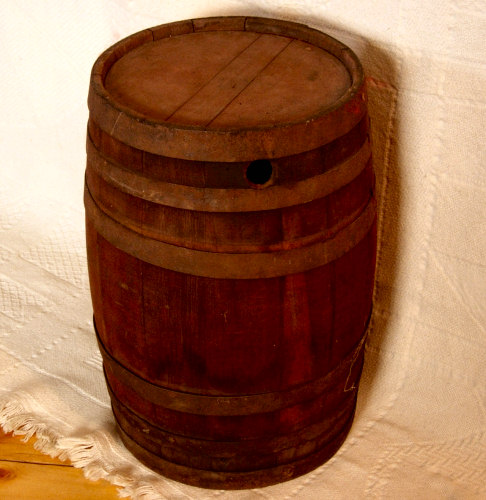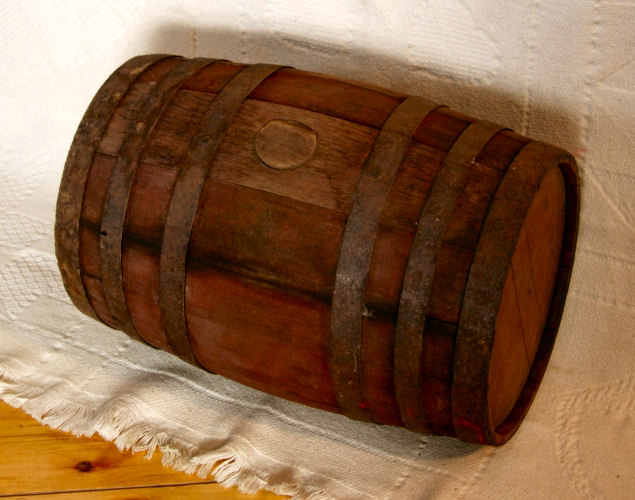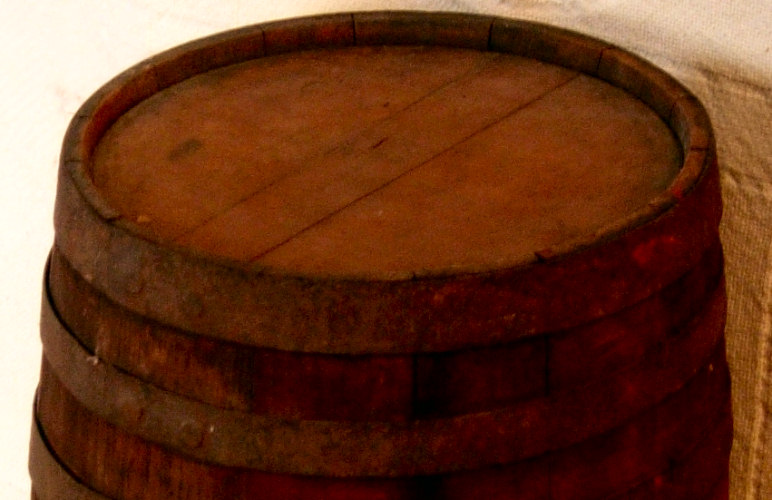This is an example of a small barrel known as a keg. It dates from the late-1800s to the early 1900s.
This barrel is a fine example of craftsmanship. All wooden barrels had to be made by hand, by a cooper. The process of making a barrel is described at the website: The Cooper, and can be accessed by clicking on the following button:

This barrel, as any barrel, was constructed of wooden staves or parallel positioned curved boards for its sides, and two circular shaped wooden forms to function as end pieces. The wooden staves of this barrel are held in place by six iron hoops, two of which hug the rims. Older barrels were held together by bent wooden hoops. This barrel was used to store, transport and dispense a liquid of some sort; that is evident because there are holes in the barrel. (A barrel intended to hold dry content would not have any holes; the content could be accessed by removing the end boards.) There are two holes in this barrel: a tap hole in one of the staves, near the rim; and a bung hole in one of the staves at its center. The tap hole measures about an inch in diameter; it was drilled into the barrel to admit a wooden tap assembly. The tap assembly was necessary to control when the liquid content could be removed from the barrel, and when not. The tap also controlled the speed and volume at which the barrel's liquid contents could be removed. The bung hole is larger than the tap hole; it is almost three inches in diameter. The bung hole was so named for the wooden stopper (i.e. the bung) that, when pounded in tightly, prevented any of the liquid content from leaking out. It was a custom to place a piece of cloth over the bung hole prior to the bung being pounded into it. The cloth, acting as a gasket, added an extra measure of leakage protection, while also providing something to grab onto when attempting to remove the bung. In practice, the user would take a mallet or hammer and tap at different points around the outside of the bung. The tapping would loosen the bung and allow it to be removed from the hole.
Although not uncommon, antique barrels are becoming scarcer as time goes on. During the period in which they were commonplace, barrels were not considered as iems to be kept. Barrels were the cardboard boaxes of their day. And as today most people do not keep the cardboard boxes in which items are shipped, people in the 1800s and early 1900s did not see the value in keeping the wooden barrels in which items were shipped. In many cases, barrels were smashed into pieces in the effort to remove the contents. Very seldom were used barrels reused. The one exception is in the liquor distillery industry. But even that is a recent development. During the colonial period, barrels were rarely recycled for whisky and other alcoholic liquors; the value of reusing old barrels to affect the flavor of the new liquor was not understood by many distillers.
As evidenced by the photos, the staves of this barrel are tight. This is rare for a wooden barrel that has not held liquid content for a long time. The liquid content would keep the wooden staves swelled, and tight. But when devoid of liquid content, a barrel's staves normally tend to shrink, and by shrinking, cracks develop between them. Since the iron rings or hoops could not be made tighter, they often became useless in holding the staves together. They could, of course, be tapped closer toward the center of the barrel, since the center bulged to the largest diameter, and therefore remain useful in holding the staves together. |





